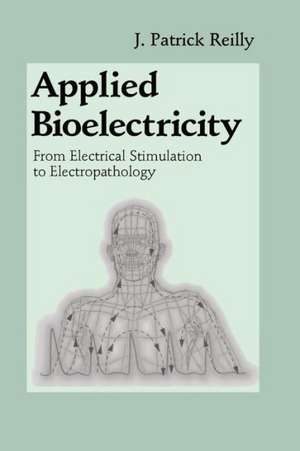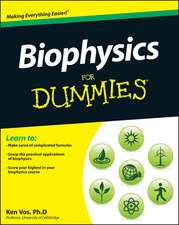Applied Bioelectricity: From Electrical Stimulation to Electropathology
Contribuţii de H. Antoni Autor J. Patrick Reilly Contribuţii de M.A. Chilbert, J.D. Sweeneyen Limba Engleză Paperback – 17 oct 2012
| Toate formatele și edițiile | Preț | Express |
|---|---|---|
| Paperback (1) | 1818.72 lei 6-8 săpt. | |
| Springer – 17 oct 2012 | 1818.72 lei 6-8 săpt. | |
| Hardback (1) | 1863.95 lei 6-8 săpt. | |
| Springer – 21 aug 1998 | 1863.95 lei 6-8 săpt. |
Preț: 1818.72 lei
Preț vechi: 2217.95 lei
-18% Nou
Puncte Express: 2728
Preț estimativ în valută:
348.22€ • 357.20$ • 293.18£
348.22€ • 357.20$ • 293.18£
Carte tipărită la comandă
Livrare economică 26 februarie-12 martie
Preluare comenzi: 021 569.72.76
Specificații
ISBN-13: 9781461272359
ISBN-10: 1461272351
Pagini: 588
Ilustrații: XIX, 563 p.
Dimensiuni: 155 x 235 x 31 mm
Greutate: 0.89 kg
Ediția:Softcover reprint of the original 1st ed. 1998
Editura: Springer
Colecția Springer
Locul publicării:New York, NY, United States
ISBN-10: 1461272351
Pagini: 588
Ilustrații: XIX, 563 p.
Dimensiuni: 155 x 235 x 31 mm
Greutate: 0.89 kg
Ediția:Softcover reprint of the original 1st ed. 1998
Editura: Springer
Colecția Springer
Locul publicării:New York, NY, United States
Public țintă
ResearchDescriere
Electric currents and electromagnetic fields have been applied to biological systems, particularly humans, with both therapeutic and pathological results. Applied Bioelectricity discusses biological responses to electric currents and electromagnetic fields, including medical applications and shock hazards. The book covers fundamental physical and engineering principles of responses to short-term electrical exposure and emphasizes human reactions, although animal responses to electricity are considered as well. The treatment covers reactions from the just-detectable to the clearly detrimental. An important new chapter discusses standards for human exposure to electromagnetic fields and electric current and demonstrates how these standards have been developed based on the principles treated in earlier chapters. J. Patrick Reilly is a member of the principal staff of the Johns Hopkins University Applied Physics Laboratory and is President of Metatec Associates.
Cuprins
1 Introduction.- 1.1 General Perspective.- 1.2 Electrical Exposure.- Electrical Fatalities.- Typical Electrical Exposures.- 1.3 Scales of Short-Term Reactions to Contact Current.- Sensory Reactions.- Muscle Reactions.- Cardiac Reactions.- Thermal Reactions.- Electroporation.- 1.4 Reactions to Electric and Magnetic Field Stimulation.- 1.5 Variables Affecting Thresholds.- 2 Impedance and Current Distribution.- 2.1 Dielectric Properties of Biological Materials.- Conductivity and Permittivity.- Cellular Membranes.- Skin Depth.- 2.2 Skin Impedance.- Detailed Structure of Skin.- Equivalent Circuit Models.- Area Proportionality of Skin Admittance.- Skin Capacitance.- Time-Variant and Nonlinear Aspects of Skin Impedance.- 2.3 Total Body Impedance: Low-Frequency and DC.- Distribution of Current and Impedance Within the Body.- Current Through the Heart.- Applicability of Measurements on Corpses.- Statistical Distribution of Impedance.- 2.4 Impedance at Higher Frequencies.- 2.5 Impedance Through Foot Contact.- 2.6 High-Voltage and Transient Properties.- Spark and Contact Components.- Plateau Voltage.- Spark Discharges and Corneal Degradation.- Discharge Impedance.- Variation with Stimulus Location.- Polarity Effects.- Stimulus Time Constants.- Minimum Impedance with Spark Discharge.- Internal Body Impedance.- 2.7 Impedance of Domestic Animals.- 3 Electrical Principles of Nerve and Muscle Function.- 3.1 Introduction.- 3.2 Cellular Membranes.- The Nernst Equation.- 3.3 The Excitable Nerve Membrane.- The Hodgkin-Huxley Membrane.- The Frankenhaeuser-Huxley Membrane.- Species Dependence of Action Potential.- Dynamics.- Propagation of Nerve Impulses.- 3.4 Action Potential Models for Cardiac Tissue.- 3.5 Sensory Transduction.- Intensity Coding.- 3.6 Muscle Function.- 3.7 Synapses.- General Properties.- Synaptic Interactions with In-Situ E-Fields.- 3.8 The Spinal Reflex.- 4 Excitation Models.- 4.1 Introduction.- 4.2 Linear Strength-Duration Model.- Empirical Strength-Duration Relationships.- 4.3 Electrical Cable Representations.- One-Dimensional Cable Models.- Nonlinear Models.- 4.4 Myelinated Nerve Model.- Threshold Criterion.- Position and Number of Nonlinear Nodes.- Suprathreshold Response.- 4.5 Response to Monophasic Stimulation.- Strength-Duration Relations.- Polarity Sensitivity.- Current Density and Electric Field.- Relationships.- 4.6 Response to Biphasic and Repetitive Stimuli.- Strength-Duration Relationships.- Sinusoidal Stimuli.- Repetitive Stimuli.- Nonlinear Interaction of Multiple Waveforms.- 4.7 Parameter Variation Effects.- 5 Electrical Properties of the Heart.- 5.1 Cardiovascular System: General Anatomical and Functional Aspects.- 5.2 Origin and Spread of Excitation.- Autorhythmicity and Geometry of Propagation.- Hierarchy of Pacemaker Activity and Artificial Pacemakers.- 5.3 Elementary Processes of Excitation and Contraction.- Ionic Mechanisms of Excitation.- Mechanism of Contraction.- Excitation-Contraction Coupling.- 5.4 Stimulation, Propagation, and Refractoriness.- Elementary Mechanisms.- Conduction of the Action Potential.- Definition and Mechanism of Refractoriness.- 5.5 Regular and Ectopic Pacemakers.- Elementary Events in Impulse Formation.- Actual and Potential Pacemakers.- Ectopic Pacemakers.- 5.6 Effects of Autonomic Nerves and of Changes in Electrolyte Composition.- Parasympathetic and Sympathetic Innervation.- Chronotropy, Inotropy, and Dromotropy.- Vagal and Sympathetic Tone.- Mechanism of Autonomic Transmitter Actions.- Effects of the Ionic Environment and of Drugs.- 5.7 Electrocardiogram.- ECG Form and Nomenclature; Relation to Cardiac Excitation.- Origin of ECG.- ECG Recording.- Use of the ECG in Diagnosis.- 5.8 Abnormalities in Cardiac Rhythm as Reflected in the ECG.- Rhythms Originating in the AV Junction.- Rhythms Originating in the Ventricles.- Extrasystoles.- Atrioventricular Disturbances of Conduction.- Atrial Flutter and Fibrillation.- Ventricular Flutter and Fibrillation.- 5.9 Mechanism of Flutter and Fibrillation.- Conditions for Reentry; Anatomical and Functional Pathways.- Length of the Excitation Wave.- Mechanisms of Abbreviated Refractory Periods.- Mechanisms of Slow Conduction.- Unidirectional Block and One-Way Conduction.- 5.10 Vulnerable Period: Threshold for Fibrillation.- The Threshold for Fibrillation.- Relation to the Threshold for Stimulation.- Effects of Alternating and Pulsed Direct Current.- Significance of Single and Repetitive Extrasystoles.- 5.11 Electrical Defibrillation.- 6 Cardiac Sensitivity to Electrical Stimulation.- 6.1 Introduction.- 6.2 Threshold Sensitivity with Respect to Cardiac Cycle.- 6.3 Strength-Duration Relations for Unidirectional Currents.- Electrode Size.- Polarity.- Size of Tissue Preparation.- Fibrillation by Prolonged Currents.- Consistency of Data.- 6.4 Biphasic and Sinusoidal Stimulation.- 6.5 Duration Sensitivity for Oscillatory Stimuli.- Excitation Sensitivity.- Fibrillation Sensitivity.- The Z Relationship for Fibrillation by AC Currents.- 6.6 Energy Criteria and Impulse Currents.- 6.7 Body-Size Scaling.- Experimental Body-Size Data.- Scaling Arguments.- 6.8 Statistical Distribution of Thresholds.- 6.9 Combined AC and DC Stimuli.- 6.10 Electrodes and Current Density.- Electrode Area.- Current Density.- Locus and Direction of Stimulus Current.- 7 Sensory Responses to Electrical Stimulation.- 7.1 Introduction.- 7.2 Mechanisms of Electrical Transduction.- 7.3 Perception of Transient Monophasic Currents.- Strength-Duration Relationships.- Capacitor Discharges.- 7.4 Suprathreshold Responses.- Magnitude Scaling.- Categorical Scaling.- AC or Repetitive Stimuli.- Dynamic Range of Electrical Stimulation.- 7.5 Stimulus Waveform Factors.- Biphasic Stimuli.- Repetitive Stimuli.- Sinusoidal Stimuli.- Polarity Effects.- 7.6 Electrodes and Current Density.- Cutaneous Electrodes.- Current Density Considerations.- 7.7 Body Location Sensitivity.- 7.8 Skin Temperature.- 7.9 Tactile Masking.- 7.10 Individual Differences in Electrical Sensitivity.- Potential Sources of Variability.- Distribution of Sensitivity.- Correlates of Sensitivity.- 7.11 Startle Reactions.- 7.12 Electrical Stimulation of Domestic Animals.- Reactions to 60-Hz Stimulation.- Reactions to Transient Stimulation.- Statistical Distribution of Bovine.- Reaction Thresholds.- Magnetic Field Stimulation of Cows.- 7.13 Visual and Auditory Effects.- 8 Skeletal Muscle Response to Electrical Stimulation.- 8.1 Introduction.- 8.2 Neuromuscular Structure and Function.- Skeletal Muscle Innervation.- Peripheral Nerve Trunk Structure.- Muscle Action Potentials and Excitation-Contraction Coupling.- Skeletal Muscle Force Production.- Differentiation of Skeletal Muscle Fiber Types.- Recruitment and Firing Patterns.- Fatigue in Normal Physiological Use.- Dynamic Nature of Skeletal Muscle Fiber Types.- 8.3 Fundamental Principles of Skeletal Muscle Electrical Stimulation.- Strength-Duration (S-D) Relations for Neuromuscular Excitation.- Regulated-Current Versus Regulated-Voltage Stimulation.- Biphasic Stimulation.- Fatigue and Conduction Failure in Response to Electrical Stimulation.- Sinusoidal Stimulation Strength-Frequency (S-F) Effects.- 8.4 Functional Neuromuscular Stimulation Systems.- Objectives and Applications of FNS Systems and Technologies.- Electrical Excitation of Skeletal Muscle by Functional Neuromuscular Stimulation.- Electrodes for Functional Neuromuscular Stimulation.- Recruitment and Rate Modulation in Functional Neuromuscular Stimulation.- Electropathology of Functional Neuromuscular Stimulation Systems.- 8.5 Skeletal Muscle Stimulation in Electrical Accidents.- History and Overview.- Let-Go Thresholds for Hand Contact with Electrical Stimuli.- 8.6 Analysis of the Let-Go Phenomenon.- Functional Anatomy of the Hand and Wrist.- Excitation Threshold Estimates.- 8.7 Effects of Electrical Stimulation on Respiration.- Anatomy and Physiology of Respiration.- Accidental Electric Shocks and Respiration.- Artificial Respiration by Electrical Stimulation.- 9 Stimulation via Electric and Magnetic Fields.- 9.1 Introduction.- 9.2 Electric Field Induction Principles.- Induction Mechanisms.- Body Surface Effects.- Induced Electric Shock Principles.- 9.3 Direct Perception of ELF Electric Fields.- Mechanisms for Human Detection.- 9.4 Human Reactions to AC Electric Field-Induced Shock.- Perception Thresholds.- Superthreshold Effects.- Multiple Discharges.- Extrapolation to Other Frequencies.- Skin Erosion from Low-Energy Discharges.- 9.5 Time-Varying Magnetic Field Induction.- 9.6 Principles of Excitation by Time-Varying Magnetic Fields.- Pulsed Fields: Large Area Exposure.- Minimum Excitation Thresholds.- Strength-Duration Time Constants.- Anatomical Considerations.- Calculated Nerve and Cardiac Excitation Thresholds.- Sinusoidal Fields: Large Area Exposure.- Criteria for Nerve and Heart Excitation: Large Area Exposure.- Body Size Scaling.- 9.7 Experimental Investigations of Magnetic Excitation: Large Area Exposure.- Thresholds for Nerve Excitation.- Thresholds for Cardiac Excitation.- Stimulus Duration and Frequency Effects.- Suprathreshold Nerve Excitation Reactions.- 9.8 Visual and Auditory Reactions to Electromagnetic Exposure.- Direct Perception of Magnetic Fields.- Visual Sensations.- Mechanisms for Phosphenes.- Duration and Frequency Relationships for Visual Effects.- Implications of Phosphenes for.- CNS Synaptic Interactions.- Auditory Sensations.- 9.9 Local Magnetic Stimulation.- Small Coil Stimulators.- Induced Electric Field.- Local Stimulation of the Brain Cortex.- 9.10 Scales of Reaction: Power Frequency.- Magnetic Field Exposure of the Head.- 9.11 Magnetic Forces on Moving Charges.- Magnetohydrodynamic Effects.- Ion Resonance.- 10 High-Voltage and High-Current Injuries.- 10.1 Introduction.- 10.2 Modes of Injury.- Thermal Injury.- Electroporation.- Fibrillation.- 10.3 Impedance Considerations and Current Distribution in the Body.- Total Body Impedance.- Contact Impedance and Segmental Body.- Impedance.- Tissue Current Densities and Current Distribution.- 10.4 Thermal Trauma.- Heating at the Contact Site.- Heating of the Tissues.- 10.5 Nonthermal Trauma.- 10.6 Lightning Injuries.- 10.7 Clinical Observations.- Electrical Burns.- Tissue Lesions.- Neurologic Sequelae.- Cardiovascular Effects.- 10.8 Clinical Treatment.- 11 Standards and Rationale.- 11.1 Introduction.- 11.2 Electromagnetic Field Exposure Standards.- Standards of the IEEE and ANSI.- Rationale for IEEE/ANSI C95.1 Standards.- Electric and Magnetic Field Criteria for IEEE/ANSI C95.1.- Induced Current and Electric Shock Considerations.- Other Standards on Electromagnetic Exposure.- Electromagnetic Exposure Limits at Low Frequencies.- Static Electric and Magnetic Fields.- 11.3 Pulsed Electromagnetic Fields.- Pulsed Field Limits in Magnetic Resonance Imaging.- Extrapolation of MRI Exposure Limits to EMF Standards.- Limits of Applicability.- 11.4 Consideration of Spark Discharges in EMF Standards.- 11.5 Absorbed Energy and Thermal Considerations in EMF Standards.- Specific Absorption Rate (SAR) Limits.- Endogenous Field Limits to EMF Interactions.- 11.6 Consideration of EMF Interaction Mechanisms in Standards Setting.- Categories of Mechanisms of Bioelectric Interaction.- Established Mechanisms for Human Bioelectric Response.- Proposed Mechanisms for Human Bioelectric Response.- 11.7 ELF Magnetic Field Standards Derived from Established Mechanisms.- Threshold Criteria.- Limit Criteria.- Other Considerations for ELF Standards.- 11.8 Standards in Consumer Products and Installations.- Standards Setting Agencies.- Safety Criteria for Consumer Products.- Hazard Criteria Versus Current Duration and Frequency.- Limits for Capacitor Discharges.- Ground Fault Current Interrupter.- References.
Caracteristici
Unique in its treatment of the short-term biological responses to electric currents and fields
Contains a chapter on developing standards for human exposure to electrical fields and currents
Contains a chapter on developing standards for human exposure to electrical fields and currents












